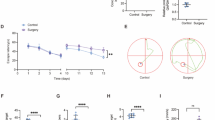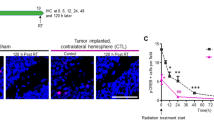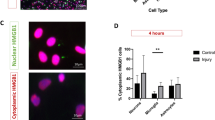Abstract
Postoperative cognitive dysfunction (POCD) is defined as a declined cognition, measured by neuropsychological tests, that persists for months or even longer after surgery. Heterogeneities in the diagnosis of POCD usually involve differences in the test batteries, the cutoffs, and the timing of assessments. Although peripheral and CSF markers of neuroinflammation have been shown to correlate with increased risk of POCD, most of them are non-specific and cannot be used for POCD diagnosis. These factors hampered the understanding of the pathogenesis of POCD as well as the development of effective preventions/treatments. In this study, we found Ttr in a panel of potential POCD biomarkers identified using time-series analysis of the transcriptomes and proteomes of the hippocampi of POCD mice that diagnosed on individual basis with composite Z-scores of test batteries consisting of Y maze and open field test. Compared with their counterparts without POCD, the levels of Ttr were significantly lower in the peripheral circulation as well as in the hippocampi of the mice developed POCD at all indicated time points after surgery. The levels of peripheral TTR in human patients with delayed neurocognitive recovery were found to be reduced at 24 h after abdominal surgery, compared with those who did not. Endogenous expression of Ttr was verified in microglia cells both in vitro and in vivo. Results of in vitro assay indicated a potential role of Ttr in ameliorating LPS-induced microglial priming and protecting the differentiation of oligodendrocyte progenitor cells (OPCs) in proinflammatory microenvironment, which was one of the determinant factors in regulating the pathological progression of POCD.
This is a preview of subscription content, access via your institution
Access options
Subscribe to this journal
Receive 12 print issues and online access
$259.00 per year
only $21.58 per issue
Buy this article
- Purchase on SpringerLink
- Instant access to full article PDF
Prices may be subject to local taxes which are calculated during checkout






Similar content being viewed by others
Data availability
The datasets used in this study are available from the corresponding author on reasonable request. The raw data are available via GEO with the accession number GSE276942.
References
Migirov A, Chahar P, Maheshwari K. Postoperative delirium and neurocognitive disorders. Curr Opin Crit Care. 2021;27:686–93.
Glumac S, Kardum G, Sodic L, Bulat C, Covic I, Carev M, et al. Longitudinal assessment of preoperative dexamethasone administration on cognitive function after cardiac surgery: a 4-year follow-up of a randomized controlled trial. BMC Anesthesiol. 2021;21:129.
Borchers F, Spies CD, Feinkohl I, Brockhaus W-R, Kraft A, Kozma P, et al. Methodology of measuring postoperative cognitive dysfunction: a systematic review. Br J Anaesth. 2021;126:1119–27.
Safavynia SA, Goldstein PA. The role of neuroinflammation in postoperative cognitive dysfunction: moving from hypothesis to treatment. Front Psychiatry. 2019;9:752.
Skvarc DR, Berk M, Byrne LK, Dean OM, Dodd S, Lewis M, et al. Post-operative cognitive dysfunction: an exploration of the inflammatory hypothesis and novel therapies. Neurosci Biobehav Rev. 2018;84:116–33.
Zhu Y-Z, Yao R, Zhang Z, Xu H, Wang L-W. Parecoxib prevents early postoperative cognitive dysfunction in elderly patients undergoing total knee arthroplasty: a double-blind, randomized clinical consort study. Medicine. 2016;95:e4082.
Zhu Y, Yao R, Li Y, Wu C, Heng L, Zhou M, et al. Protective effect of celecoxib on early postoperative cognitive dysfunction in geriatric patients. Front Neurol. 2018;9:633.
Ottens TH, Dieleman JM, Sauër A-MC, Peelen LM, Nierich AP, de Groot WJ, et al. Effects of dexamethasone on cognitive decline after cardiac surgery: a randomized clinical trial. Anesthesiology. 2014;121:492–500.
Magalhães J, Eira J, Liz MA. The role of transthyretin in cell biology: Impact on human pathophysiology. Cell Mol Life Sci. 2021;78:6105–17.
Giannocco G, Kizys MML, Maciel RM, de Souza JS. Thyroid hormone, gene expression, and Central Nervous System: Where we are. Semin Cell Dev Biol. 2021;114:47–56.
Siddiqi OK, Ruberg FL. Cardiac amyloidosis: an update on pathophysiology, diagnosis, and treatment. Trends Cardiovasc Med. 2018;28:10–21.
Palha JA, Episkopou V, Maeda S, Shimada K, Gottesman ME, Saraiva M. Thyroid hormone metabolism in a transthyretin-null mouse strain. J Biol Chem. 1994;269:33135–9.
van Bennekum AM, Wei S, Gamble MV, Vogel S, Piantedosi R, Gottesman M, et al. Biochemical basis for depressed serum retinol levels in transthyretin-deficient mice. J Biol Chem. 2001;276:1107–13.
Refetoff S. Defects of thyroid hormone transport in serum. Endotext [Internet] 2023.
Gomes J, Nogueira R, Vieira M, Santos S, Ferraz-Nogueira J, Relvas J, et al. Transthyretin provides trophic support via megalin by promoting neurite outgrowth and neuroprotection in cerebral ischemia. Cell Death Differ. 2016;23:1749–64.
Vieira M, Leal SS, Gomes CM, Saraiva MJ. Evidence for synergistic action of transthyretin and IGF-I over the IGF-I receptor. Biochim Biophys Acta. 2016;1862:797–804.
Zhou L, Tang X, Li X, Bai Y, Buxbaum JN, Chen G. Identification of transthyretin as a novel interacting partner for the δ subunit of GABAA receptors. PLoS One. 2019;14:e0210094.
Li X, Masliah E, Reixach N, Buxbaum JN. Neuronal production of transthyretin in human and murine Alzheimer’s disease: is it protective? J Neurosci. 2011;31:12483–90.
Serot J, Christmann D, Dubost T, Couturier M. Cerebrospinal fluid transthyretin: aging and late onset Alzheimer’s disease. J Neurol, Neurosurg Psychiatry. 1997;63:506–8.
A Ribeiro C, Santana I, Oliveira C, Baldeiras I, Moreira J, et al. Transthyretin decrease in plasma of MCI and AD patients: investigation of mechanisms for disease modulation. Curr Alzheimer Res. 2012;9:881–9.
Gião T, Saavedra J, Cotrina E, Quintana J, Llop J, Arsequell G, et al. Undiscovered roles for transthyretin: from a transporter protein to a new therapeutic target for Alzheimer’s disease. Int J Mol Sci. 2020;21:2075.
Kotekar N, Shenkar A, Hegde AA. Anesthesia Issues in Geriatrics. In: Goudra B, editors. Anesthesiology. Springer, Cham; 2018. p 795–825.
Schaefer ST, Koenigsperger S, Olotu C, Saller T. Biomarkers and postoperative cognitive function: could it be that easy? Curr Opin Anesthesiol. 2019;32:92–100.
Feng X, Valdearcos M, Uchida Y, Lutrin D, Maze M, Koliwad SK. Microglia mediate postoperative hippocampal inflammation and cognitive decline in mice. JCI insight. 2017;2:e91229.
Qiu L-L, Pan W, Luo D, Zhang G-F, Zhou Z-Q, Sun X-Y, et al. Dysregulation of BDNF/TrkB signaling mediated by NMDAR/Ca2+/calpain might contribute to postoperative cognitive dysfunction in aging mice. J Neuroinflammation. 2020;17:1–15.
Lai Z, Shan W, Li J, Min J, Zeng X, Zuo Z. Appropriate exercise level attenuates gut dysbiosis and valeric acid increase to improve neuroplasticity and cognitive function after surgery in mice. Mol Psychiatry. 2021;26:7167–87.
Han X, Cheng X, Xu J, Liu Y, Zhou J, Jiang L, et al. Activation of TREM2 attenuates neuroinflammation via PI3K/Akt signaling pathway to improve postoperative cognitive dysfunction in mice. Neuropharmacology. 2022;219:109231.
Liang X, Liu T, Li L, Li J, Li S, Zeng K, et al. Translational selenium nanotherapeutics counter-acts multiple risk factors to improve surgery-induced cognitive impairment. Chem Eng J. 2022;441:135984.
Liang X, Xue Z, Zheng Y, Li S, Zhou L, Cao L, et al. Selenium supplementation enhanced the expression of selenoproteins in hippocampus and played a neuroprotective role in LPS-induced neuroinflammation. Int J Biol Macromol. 2023;234:123740.
Zhang Q, Li S-Z, Feng C-s, Qu X-D, Hui W, Zhang X-N, et al. Serum proteomics of early postoperative cognitive dysfunction in elderly patients. Chin Med J. 2012;125:2455–61.
Wu B, Liu J, Zhao R, Li Y, Peer J, Braun AL, et al. Glutaminase 1 regulates the release of extracellular vesicles during neuroinflammation through key metabolic intermediate alpha-ketoglutarate. J Neuroinflammation. 2018;15:1–14.
Fleming CE, Mar FM, Franquinho F, Saraiva MJ, Sousa MM. Transthyretin internalization by sensory neurons is megalin mediated and necessary for its neuritogenic activity. J Neurosci. 2009;29:3220–32.
Peng H, Bria A, Zhou Z, Iannello G, Long F. Extensible visualization and analysis for multidimensional images using Vaa3D. Nat Protoc. 2014;9:193–208.
Yu B, Liu J, Su M, Wang C, Chen H, Zhao C. Disruption of Foxg1 impairs neural plasticity leading to social and cognitive behavioral defects. Mol Brain. 2019;12:1–12.
Wang S, Li W, Hu L, Cheng J, Yang H, Liu Y. NAguideR: performing and prioritizing missing value imputations for consistent bottom-up proteomic analyses. Nucleic Acids Res. 2020;48:e83.
Gatto L, Lilley KS. MSnbase-an R/Bioconductor package for isobaric tagged mass spectrometry data visualization, processing and quantitation. Bioinformatics. 2012;28:288–9.
VanDusen KW, Li Y-J, Cai V, Hall A, Hiles S, Thompson JW, et al. Cerebrospinal fluid proteome changes in older non-cardiac surgical patients with postoperative cognitive dysfunction. J Alzheimer’s Dis. 2021;80:1281–97.
Liz MA, Coelho T, Bellotti V, Fernandez-Arias MI, Mallaina P, Obici L. A narrative review of the role of transthyretin in health and disease. Neurol Ther. 2020;9:395–402.
Dennis J, Morgan MK, Graf MR, Fuss B. P2Y12 receptor expression is a critical determinant of functional responsiveness to ATX’s MORFO domain. Purinergic Signal. 2012;8:181–90.
Evered LA, Silbert BS. Postoperative cognitive dysfunction and noncardiac surgery. Anesth Analg. 2018;127:496–505.
Li Y, Chen D, Wang H, Wang Z, Song F, Li H, et al. Intravenous versus volatile anesthetic effects on postoperative cognition in elderly patients undergoing laparoscopic abdominal surgery: a multicenter, randomized trial. Anesthesiology. 2021;134:381–94.
Zhong J, Li J, Miao C, Zuo Z. A novel individual-based determination of postoperative cognitive dysfunction in mice. Aging Dis. 2020;11:1133.
Alshehri B, D’Souza DG, Lee JY, Petratos S, Richardson SJ. The diversity of mechanisms influenced by transthyretin in neurobiology: development, disease and endocrine disruption. J Neuroendocrinol. 2015;27:303–23.
Vieira M, Saraiva MJ. Transthyretin: a multifaceted protein. Biomol Concepts. 2014;5:45–54.
Gomes JR, Cabrito I, Soares HR, Costelha S, Teixeira A, Wittelsberger A, et al. Delivery of an anti-transthyretin nanobody to the brain through intranasal administration reveals transthyretin expression and secretion by motor neurons. J Neurochem. 2018;145:393–408.
Velayudhan L, Killick R, Hye A, Kinsey A, Güntert A, Lynham S, et al. Plasma transthyretin as a candidate marker for Alzheimer’s disease. J Alzheimer’s Dis. 2012;28:369–75.
Gloeckner SF, Meyne F, Wagner F, Heinemann U, Krasnianski A, Meissner B, et al. Quantitative analysis of transthyretin, tau and amyloid-β in patients with dementia. J Alzheimer’s Dis. 2008;14:17–25.
Choi SH, Leight SN, Lee VM-Y, Li T, Wong PC, Johnson JA, et al. Accelerated Aβ deposition in APPswe/PS1δE9 mice with hemizygous deletions of TTR (transthyretin). J Neurosci. 2007;27:7006–10.
Buxbaum JN, Ye Z, Reixach N, Friske L, Levy C, Das P, et al. Transthyretin protects Alzheimer’s mice from the behavioral and biochemical effects of Aβ toxicity. Proc Natl Acad Sci. 2008;105:2681–6.
Brettschneider J, Lehmensiek V, Mogel H, Pfeifle M, Dorst J, Hendrich C, et al. Proteome analysis reveals candidate markers of disease progression in amyotrophic lateral sclerosis (ALS). Neurosci Lett. 2010;468:23–27.
Salazar IL, Lourenço AS, Manadas B, Baldeiras I, Ferreira C, Teixeira AC, et al. Posttranslational modifications of proteins are key features in the identification of CSF biomarkers of multiple sclerosis. J Neuroinflammation. 2022;19:44.
Masuda T, Sankowski R, Staszewski O, Prinz M. Microglia heterogeneity in the single-cell era. Cell Rep. 2020;30:1271–81.
Borst K, Prinz M. Deciphering the heterogeneity of myeloid cells during neuroinflammation in the single-cell era. Brain Pathol. 2020;30:1192–207.
Shen M, Shang M, Tian R, Hu Y, Han Q, Hu J, et al. Single cell molecular alterations reveal target cells and pathways of conditioned fear memory. Brain Res. 2023;1807:148309.
Xu M, Sulkowski Z, Parekh P, Khan A, Chen T, Midha S, et al. Effects of perinatal lipopolysaccharide (LPS) exposure on the developing rat brain; modeling the effect of maternal infection on the developing human CNS. Cerebellum. 2013;12:572–86.
Gomes JR, Lobo A, Nogueira R, Terceiro AF, Costelha S, Lopes IM, et al. Neuronal megalin mediates synaptic plasticity—a novel mechanism underlying intellectual disabilities in megalin gene pathologies. Brain Commun. 2020;2:fcaa135.
Mulder SD, Veerhuis R, Blankenstein MA, Nielsen HM. The effect of amyloid associated proteins on the expression of genes involved in amyloid-β clearance by adult human astrocytes. Exp Neurol. 2012;233:373–9.
Liz MA, Fleming CE, Nunes AF, Almeida MR, Mar FM, Choe Y, et al. Substrate specificity of transthyretin: identification of natural substrates in the nervous system. Biochem J. 2009;419:467–74.
Costa R, Ferreira-da-Silva F, Saraiva MJ, Cardoso I. Transthyretin protects against A-beta peptide toxicity by proteolytic cleavage of the peptide: a mechanism sensitive to the Kunitz protease inhibitor. PLoS one. 2008;3:e2899.
Vieira M, Gomes JR, Saraiva MJ. Transthyretin induces insulin-like growth factor I nuclear translocation regulating its levels in the hippocampus. Mol Neurobiol. 2015;51:1468–79.
Nieto-Estévez V, Defterali Ç, Vicario-Abejón C. IGF-I: a key growth factor that regulates neurogenesis and synaptogenesis from embryonic to adult stages of the brain. Front Neurosci. 2016;10:52.
Chiu S-L, Cline HT. Insulin receptor signaling in the development of neuronal structure and function. Neural Dev. 2010;5:1–18.
Yuelling LM, Fuss B. Autotaxin (ATX): a multi-functional and multi-modular protein possessing enzymatic lysoPLD activity and matricellular properties. Biochim Biophys Acta. 2008;1781:525–30.
Nogaroli L, Yuelling LM, Dennis J, Gorse K, Payne SG, Fuss B. Lysophosphatidic acid can support the formation of membranous structures and an increase in MBP mRNA levels in differentiating oligodendrocytes. Neurochem Res. 2009;34:182–93.
Berbel P, Guadan A, Angulo A. Role of thyroid hormones in the maturation of interhemispheric connections in rats. Behav Brain Res. 1994;64:9–14.
Alshehri B, Pagnin M, Lee JY, Petratos S, Richardson SJ. The role of transthyretin in oligodendrocyte development. Sci Rep. 2020;10:4189.
Brouillette J, Quirion R. Transthyretin: a key gene involved in the maintenance of memory capacities during aging. Neurobiol Aging. 2008;29:1721–32.
Acknowledgements
This work was sponsored by the Guangdong Provincial Key R&D Program of Department of Natural Resources of Guangdong Province (#2023B1111050011) and the Natural Science Foundation of Guangdong (#2023A1515010293).
Author information
Authors and Affiliations
Contributions
XL established the mouse model, performed western blot assay, bioinformatic analysis and data process. CS processed the sequencing data, conducted the ELISA assay and in vitro studies. JL conducted the clinical trial. SL performed immunohistology assay and Golgi staining. LL and GD performed the performed exosome isolation and uptake experiments. RZ performed qPCR and the image analysis. OMZ and HY assist mouse work and data processing. LZ helped data analysis. YZ supervised the project, conceived this research, drafted the paper, designed the experiment, and interpreted the data. YZ is the guarantor. The corresponding author attests that all listed authors meet authorship criteria and that no others meeting the criteria have been omitted.
Corresponding author
Ethics declarations
Competing interests
The authors declare no competing interests.
Ethical approval & consent to approval
The procedures involving animals were performed in accordance with the animal research committee of Jinan University and the National Institutes of Health (NIH) Guide for the Care and Use of Laboratory Animals. All animal experiments were approved by the Institutional Animal Care and Use Committee of Jinan University (IACUC-20230625-07). The clinical trial study was approved by the internal review and ethics boards of Sun Yat-sen Memorial Hospital (Approval No: 2022-KY–072, Registration No: ChiCTR2300069362). All methods were performed in accordance with the relevant guidelines and regulations.
Additional information
Publisher’s note Springer Nature remains neutral with regard to jurisdictional claims in published maps and institutional affiliations.
Rights and permissions
Springer Nature or its licensor (e.g. a society or other partner) holds exclusive rights to this article under a publishing agreement with the author(s) or other rightsholder(s); author self-archiving of the accepted manuscript version of this article is solely governed by the terms of such publishing agreement and applicable law.
About this article
Cite this article
Liang, X., Song, C., Lin, J. et al. Transthyretin, a novel prognostic marker of POCD revealed by time-series RNA-sequencing analysis. Mol Psychiatry 30, 3103–3119 (2025). https://doi.org/10.1038/s41380-025-02918-0
Received:
Revised:
Accepted:
Published:
Issue date:
DOI: https://doi.org/10.1038/s41380-025-02918-0



